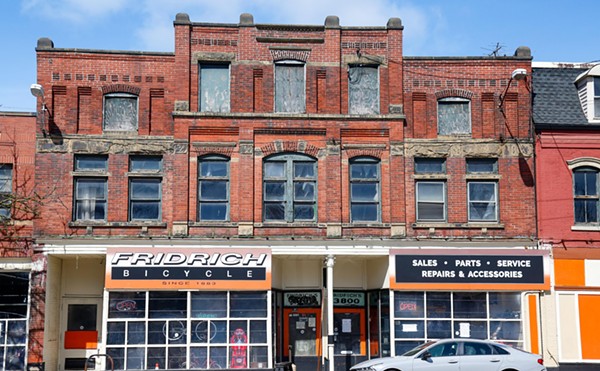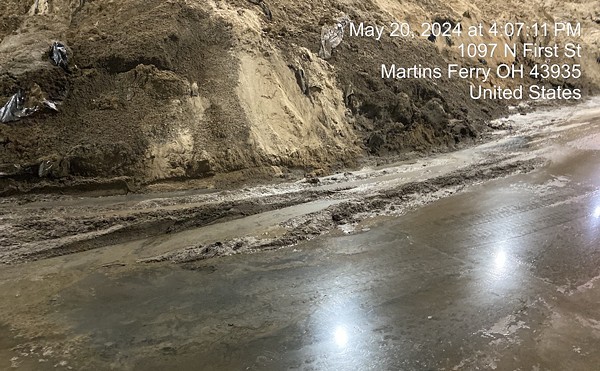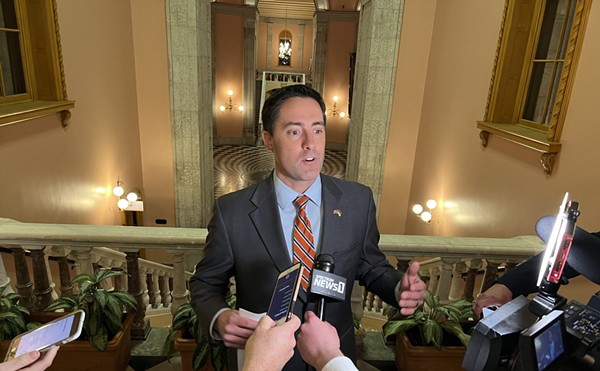That's from the surgery to remove the cancer in his eyeball. It spread from his brain.
He remembers standing at the station one day, looking at something on the wall. Then blackness. Only later did he learn that someone was yelling for his attention. Berger just stood there like a zombie. Then he started spinning in circles. His eyes rolled back. His head hit the floor.
An MRI showed he had nervous system lymphoma, a rare type of brain cancer usually reserved for people with AIDS or those recovering from an organ transplant. But Jason had never smoked. He stayed away from fast food, religiously worked out, never been sick.
It would appear a case of horribly bad luck -- except that he's the third person from his old Valley View neighborhood to get brain tumors or lesions, another in a long line afflicted with all manner of rare and lethal illnesses.
Neighbor Yvonne Sims, an office lady at Cuyahoga Heights High School, developed Parkinson's in her late forties. It started out as a hand tremor. Pretty soon she couldn't get out of a wheelchair.
Just a few doors down was Sharon Campoy, who died of lupus when she was 42.
Shirley Boberek's daughter has had three miscarriages.
Carol Calderone's son had a baby born with DiGeorge syndrome, which stunts the growth of heart and lungs. The girl died after seven months on tubes.
And these are but the first few names on the list.
So it's natural Berger looks for someone to blame. That old landfill at the end of the street is a good place to start. For decades, neighbors suspected it harbored toxic waste -- the kind of stuff that makes Agent Orange seem like Sierra Mist. But no one would listen.
After all, science has yet to locate specific causes for most cancers. They can arrive from pretty much anywhere -- air, water, food, genes. Rare is the smoking gun. And given Ohio's industrial history, even rarer is the government agency willing to look.
But in this case, Berger has the smoking gun.
Murray and Fosdick Roads used to be considered "out in the country."
The two quiet streets in Valley View, connected by the aptly named Tiny Lane, were as close to wilderness as you could get in a city so polluted you could drop a cigar butt in the river and the thing would explode.
To the west were cornfields and the Cuyahoga River. Behind the homes to the east, into Garfield Heights, climbed a densely wooded hill that seemed to stretch to the clouds and ignite in flames of foliage each autumn.
Then came the dump. It started as a small operation in 1966, run by a real estate tycoon named Ralph Conte. In 1971, after falling ill, Conte turned it over to Pete Boyas, a high-rolling excavator with a penchant for peach-colored leisure suits and patent-leather shoes. Boyas had big plans.
With the old dump filled to the brim, he expanded to that beautiful hill, bulldozed the trees like toothpicks, dynamited the center, and filled it with trash and sewage. "It looked like the moon," remembers former resident Ted Funk.
But losing the view was soon neighbors' last worry. Water oozed out of the dump, into their creeks and front yards, before flowing out to the river. The stream that separated their backyards was once so crystal-clear that you could bottle it. Now it alternated between bright orange, black, and green, replete with an oil rainbow and a crust of white foam. It wasn't unusual to see hypodermic needles floating by.
"When you were really bad and we fought, we would push each other in it," says Jennifer Hudson, who grew up with the dump.
Then there was the smell, like vomit steaming in a summer-camp dumpster. Boyas tried spraying the dump with chemicals to kill the stench, but that only made it worse.
Remembers longtime resident George Sloat: "When you open up the front door, your eyes would water."
First there was Sandy Funk. She thought she was going crazy.
In 1984, eight years after moving into her home on Murray Road, the 37-year-old housewife started having blackouts, feeling like she was trapped in a dark tunnel.
Doctors were clueless. One suggested it was low blood sugar. Another assured her she was just having panic attacks.
Then, at a family picnic in 1986, "She was talking, and she just started shaking real bad, and her eyes rolled back in her head, and she just passed out," remembers husband Ted.
An MRI showed what doctors had missed: a brain tumor. They were able to remove two-thirds of it in surgery -- in which they accidentally scalped the top of her head, so hair would never grow there again. Doped up on painkillers and having her head microwaved once a week, Funk spent most of her days in bed. She withered away to a skeleton.
For the next 18 years, she kept herself alive with natural juices and vitamins.
Then others got sick. In 1999, Dale Kattler, only 29 years old, got a brain tumor the size of a golf ball. Luckily, it was benign.
One by one, the neighbors started coming down with nasty diseases. There was Linda Lloyd, who lost her father to lymphoma, her mother to liver cancer, and her 53-year-old husband to lung cancer.
Kattler's parents also faced cancer -- Dad in the thyroid, Mom in her breast.
Fifty-six-year-old Ed Bartko was healthy as a teenager -- didn't smoke, didn't drink, and he ate lots of vegetables from the family's huge garden out back. One day in 2001, he started urinating blood; he found out he had kidney cancer and was dead six months later.
That same year, Margaret Berger, Jason's mom, was diagnosed with liver cancer and given six months to live. She lost half her body weight, finally dying in the hospital after uncontrollably throwing up black bile and crying for God to take her.
At the funeral -- closed casket -- Sandy Funk showed up, emaciated and wearing a wig. She lost her balance trying to stand; Jason's buddy reached out and caught her. A couple months after the funeral, she died too.
Before the next funeral is his, Jason wants to find out what happened to his neighborhood, what's really buried in that landfill, where the boys from the neighborhood used to ride bikes, explore, and hide their dirty magazines.
"Something obviously dirty is going on up there," he says. "I'm a pretty healthy guy, my mom was pretty healthy, we both worked out, and my mom's in the ground, and I'm probably not far away."
Nobody knows what's buried up there.
In the '60s and '70s, dumps operated almost free of regulation. There were rules, of course, that said you couldn't unload a truck of hazardous waste at the town landfill, but the only people watching were county health inspectors, who split their time between policing restaurants and public swimming pools. Besides, if there was smoke coming out of the stacks, there were jobs being made -- and that was real health.
But only a small number of dumps were actually permitted to accept hazardous waste. Being on the up-and-up might mean driving as far as Niagara Falls, then paying up to $100 per barrel to get rid of it. Garfield Heights, on the other hand, was just a quick shot down Broadway. Grease the guy at the gate, and there's no telling what you could get through.
The state admits it was happening. In a 1979 article in the Cleveland Press, Ohio EPA officials said they had no idea what was piling up in landfills.
"We realize there are a lot of hazardous wastes being produced around here that do not go to [hazardous waste] facilities," agent Mark Bergman told the reporter. "It is common knowledge."
Donald Day, the Ohio EPA's chief of land pollution, casually admitted that jobs trumped environmental concerns.
"These workers have a stake in seeing that these wastes can be disposed of," he is quoted as saying. "Otherwise, some industries might have to close and the jobs will be lost."
The story appeared during the era of Love Canal. Residents next to a landfill in Niagara Falls, New York, had to be evacuated after toxic wastes from a nearby landfill were proved to have directly caused a slew of cancers and birth defects in their neighborhood.
Day admitted that he couldn't "say that it couldn't happen here." But you can't ask Boyas what's buried on that hill. He died a sick old man in 2002. Son Mike, the new boss at Boyas Excavating, was only a teenager when his father ran the dump, but he remembers state inspectors being a pain in the old man's ass.
"If anything, it was very scrutinized," he says. "There was no playing games."
But there were ways around the rules. There's a memo on Boyas' stationery relating to a request to dump 2,500 gallons per month of ink waste -- containing high amounts of lead -- from St. Regis Paper Company. And there's a typed request to the Ohio EPA, asking for approval to serve as an emergency dump for sludge from the Jones & Laughlin steel mill. There's no documentation, however, of whether the Ohio EPA approved it.
On Conte's old section of the dump, there's no question that something dangerous is in the soil. A 1986 assessment by the Ohio EPA cites another report from 1979, which states that an unnamed chemical company once dumped hazardous wastes there. But that report has mysteriously disappeared from the file.
The people of Murray and Fosdick don't need reports. They trust their own eyes.
Berger remembers lying awake in his bed on summer nights, listening to the backup alarms on dump trucks, while the stink that levitated above the landfill in the afternoon heat rolled down the hill like a poison fog.
"Who the hell's dumping at those hours of the day?" he now wonders.
Shirley Boberek would often see a hospital truck drive up the hill. "That was sort of scary," she says. "I always laughed and said, 'Maybe we got Hoffa in there.'"
Sandy Funk's son Toby remembers exploring there as a kid. One day he and some friends found steel drums that had tipped over, spilling a white, meringue-like muck. They played in it, stomping through the hard crust down to the soft foam below. "We were a bit freaked out by it," says Toby.
Eerily, a 1995 clipping from the Garfield Heights Leader shows an aerial photo of the Boyas dump, taken in 1975. The photo shows a pile of steel drums, contents unknown.
In a state that handed Tom Noe $50 million to invest in rare coins, it's scary to imagine how it deals with toxic dumps.
While the rest of the country began its environmental enlightenment 30 years ago, the Ohio EPA's legacy is one of sticking to the rules of the industrial revolution, circa 1900: Look the other way while industry squats in the bushes to do its business.
In 1994, for example, U.S. EPA scientists found a host of violent, cancer-causing chemicals in the soil and groundwater near a factory in Middlefield. But rather than launch an emergency cleanup, the state did nothing for seven years, while nearby residents came down with cancers and neurological disorders. The situation was chronicled in "While the EPA Slept" (Scene, November 15, 2001), and the agency has since had a "directive" not to talk to Scene, says spokeswoman Dina Pierce.
Its partner in protecting the public, the Ohio Department of Health takes a similar see-no-evil approach. In 2001, its chief investigator, Robert Indian, released a report on a mysterious rash of cancers afflicting graduates of a Marion County high school, who suffered from leukemia at three times the normal rate ("Stonewall," April 23, 2003). Though the school was built on an old military depot known to house hazardous waste, Indian comically blamed the cancer on teen tobacco use -- despite no evidence that Marion County kids smoked more than anywhere else.
But it remains the default story line for both agencies: Ignore a problem for years, take additional years to conduct the most cursory investigation possible, then declare no evidence of public danger.
The residents of Murray and Fosdick know the drill. In the '70s, when Boyas started turning their streams the color of the General Lee's paint job, a group of neighborhood women organized to fight him.
They stood up at council meetings, picketed dump trucks, and even testified in Columbus to shut Boyas down. But the newly created Ohio EPA took up arms with the other side. When Garfield Heights City Council voted to oppose Boyas' request to expand the dump, EPA Director Ned Williams -- against the advice of his own engineer, who testified it was a health hazard -- went over their heads and gave Boyas the permit anyway.
In 1977, when Valley View Mayor Art Westfall complained about the goo dripping into his town, the EPA sat on his complaint for almost three years, then summarily dismissed it. "The nuisance condition . . . was justified," wrote Williams' successor, James McAvoy. The law "does not address nuisances."
"Five years of my life I took away from my kids, trying to do something," says resident Eleanor Sloat, who was active in the neighborhood group. "And we accomplished nothing."
The dump finally closed in 1979, but it was far from an end to the problems. For the next two decades, putrid water continued to drain into the backyards of Murray and Fosdick, as well as neighborhoods in Garfield Heights.
Boyas, meanwhile, had washed his hands of the mess. The law said that three years after he closed the dump, he was officially free of responsibility for it. In 1984, a company run by Ohio Republican Chairman Bob Bennett bought it to lease for natural gas mining, but the market bottomed, and the venture flopped. (Bennett did not return Scene's calls.)
The Ohio EPA also took itself off the hook. When it got complaints, it sent agents out to collect samples. Besides smelling and looking like radioactive waste, there was nothing wrong with the water, the agency ruled. Problem solved.
"Without having the presence of hazardous substances being released . . . [the Ohio EPA] lacks the authority to compel the responsible parties to mitigate those releases," an engineer wrote to a Garfield Heights resident.
Even the feds didn't seem concerned. In 1988, the U.S. EPA descended on Garfield Heights after explosive methane gas produced by the landfill crept into nearby apartments. Residents were hopeful the feds, considered real regulators, would be shocked to see the filth running into their backyards. But at a public meeting, the EPA's Joe Fredle offered the same line they'd always heard: "At present it is not an [imminent] danger to the public."
Perhaps the feds never saw the tests from four years earlier. It showed that a gas well drilled at the dump contained the mother of all cancer-causing chemicals.
Bruce Molholt knows vinyl chloride all too well.
It's a universally "known brain carcinogen," says the retired U.S. EPA toxicologist, who now spends his time as something of an Erin Brockovich, investigating cancer clusters and providing expert testimony in cases against industrial polluters.
Vinyl chloride, used for years to make PVC pipes, and a natural by-product of industrial degreasers, was found at such a level that Molholt describes it as "one of the highest cancer risks I've ever seen associated with a hazardous waste site."
Most agencies armed with that kind of knowledge would declare a public danger and launch an emergency cleanup. But the Ohio EPA did nothing. It seems that because only a handful of residents were at risk, it wasn't worth the effort. Wrote an EPA engineer of the equally dirty Conte dump: "Due to the small size of the potential target population, it is recommended that this site receive a low priority."
Yet Boyas would return to the picture a decade later with an idea that allowed everyone to save face: He wanted to build an office park there. Garfield Heights Mayor Tom Longo, stuck in a town with no available land -- save for a dozen oozing dumps -- jumped aboard. The only obstacle was getting Ohio EPA approval.
But the EPA, it turned out, was just as pumped, says Ed McCabe, the engineer hired by Boyas. The feds' Superfund program never had extra money, and no one was tending to the property. The state figured it would just let a private developer seal the whole thing off with buildings and parking lots.
"This could be a win-win-win for both the State of Ohio, the EPA, the developers, everybody that dumped garbage into that landfill, and everybody that's going to live in that area for the next 1,000 years," says McCabe, referring to his conversations with the EPA. "The idea is to make it . . . more watertight."
But apparently the state neglected to tell all involved they were building atop the Satan of brain-cancer-causing agents. If one ignored the tests, the odors, and the menacing water, it was nothing worse than an old garbage dump. So Boyas got his permit.
The rest of the city would finally see what the residents of Murray and Fosdick were telling them all along.
The stink from excavation was unimaginable, like pulling the lid off a carton of leftovers -- only the carton was 30 years old, as deep as a canyon, as wide as . . . well, a huge office park.
In 2001, residents packed a Garfield Heights Council meeting. The fumes were giving them bloody noses, fever, even numbness. It was like being trapped in an unventilated room with an open can of shellac.
"We aren't just talking about a bad smell here," says Debbie Altenbernd of Garfield Heights. "It's not just methane."
To quell the fears, Mayor Longo hired a consultant to test the air for mold spores. The health department tested for other gases. But that was the least of their concerns.
Boyas had partnered with developers Bart Wolstein and John McGill, who envisioned building a massive big-box complex on top of the dump, along the lines of Steelyard Commons. After Boyas died, the two developers bought the land for $13 million. Then Wolstein died, and McGill was left to handle the project himself.
In March 2005, with still no sufficient tests to see what toxins permeated the ground, the Ohio EPA granted McGill approval to start construction on the City View shopping center.
It wasn't until tens of millions of cubic feet of garbage had been dug up, countless steel pilings had been drilled down to bedrock, and foundations were being laid down, that the EPA decided it might be wise to conduct water tests -- five years after it approved the project.
Construction had been messier than expected. McGill set up tanks to pump out the orange funk draining from the cupcake-like mound, but he couldn't catch it all. The ooze was running off the site. The Ohio EPA turned up the heat on McGill by fining him, but it's hard to plug a million holes at once.
On November 8, 2005, EPA inspector Frank Zingales filled up jars with the red, bubbling muck. Co-worker Steve Tuckerman, who analyzed the results, was shocked.
The levels of toxins were "among the highest in my experience of more than 20 years of evaluating water quality," Tuckerman wrote in a memo. "They indicate grossly polluted conditions."
And, sure enough, tucked among the list of 10-syllable offenders was the monster of brain cancer, vinyl chloride.
The results by themselves are damning. But Molholt suspects the levels are even higher under the surface, because vinyl chloride quickly evaporates when exposed to air. He says the residents of Murray and Fosdick were likely exposed to even greater amounts from breathing noxious fumes all those years.
Just as scary was the fact that the neighborhood was still using well water while the dump was going full-swing. When the water started tasting funny, people would haul in jugs of tap water from outside the city, but they still showered, brushed their teeth, did laundry.
Murray got city water installed in 1973, but Fosdick residents had to wait until 1976 before their wells were turned off. Even after that, Ted Funk says, water would seep into his basement, sometimes leaving a foamy white residue on the block.
"People are both exposed in their drinking water, in their indoor air, and then if they wander outside," Molholt says. "It's been a triple whammy for them."
Now the Ohio EPA may have created the cancer cluster of the future, within the hundreds of employees who man the cash registers and stock the shelves at City View. The trash beneath their feet produces large amounts of natural gas, or methane. By itself, it's harmless, unless it reaches explosive limits. But as it percolates up through the garbage, so will the vinyl chloride.
"If you're making methane, you're making vinyl chloride; there's absolutely no question about it," says Molholt. "This is a perfect situation to gas people . . . like Auschwitz."
There are safeguards. Layers of clay, concrete, gravel, and a vinyl-like material under the buildings, combined with vents overhead, are supposed to prevent gas from getting in. But the system isn't perfect. An exhaust system could fail, a seal could be broken. And alarms inside each building are designed to detect explosive levels of gas. They can't tell you if you're slowly developing cancer.
Not that the Ohio EPA wanted you to know this. The agency never publicly announced its findings, burying them instead inside thousands of pages of benign records.
But Home Depot, which was planning a store at City View, conducts its own research. Three months before the EPA tests, the home-improvement giant sent a consultant, who found that industrial degreasers that degrade into vinyl chloride had seeped deep into the groundwater.
Last March, the company met with the Ohio EPA to talk about the problem. It discussed enrolling the Home Depot site in the state's program for brownfields. But the talks produced nothing, and the agency allowed construction to proceed for stores like Bed Bath & Beyond, PetSmart, Wal-Mart, Giant Eagle, Circuit City, and A.J. Wright. Even though no one knew what was lurking in the ground underneath.
As of last week, the EPA hadn't even told Mayor Longo what it found.
"If there'd been any hazardous stuff down there, the EPA would have shut the project down completely," Longo assured a reporter. "They watched this thing like a hawk."
Then Scene told him about the report.
"What are you gonna do, tear the whole place down and tell everybody to get out?" he yelled. "I've got a $100 million investment sitting down there!"
Nor was the Cuyahoga County Board of Health informed. "That's interesting, something I'd like to know about," says Denise Romano, who oversees the area that includes Garfield Heights.
In December, Wal-Mart was forced to evacuate after gas was detected in the store for a second time. But it was blamed on a faulty floor drain emitting sewer gas.
A.J. Wright also had a methane sensor go off. This time a faulty heating unit was fingered.
There have been numerous other false alarms. PetSmart blamed aerosol dog-grooming products. Sally Beauty Supply blamed a cleaning product.
At Nails & Company, a contractor installing a floor tub for manicures accidentally broke through a layer of the gas barrier, but the Ohio EPA didn't find out about it until five months later.
While he admits that "You could make this place look like the worst thing since Hiroshima," Ed McCabe, as well as a lawyer for McGill, insists City View is a "home run" for all.
"The state should be up there building a statue of John McGill," McCabe says. "How much has the quality of life for those people improved because of this project?"
On Murray and Fosdick, you'd have a hard time finding someone to second that motion.
Angry doesn't come close to describing Ted Funk.
He speaks of his wife's death, voice slow and deliberate. The retired electrical lineman with a full head of silver hair stares intently at his powerful hands, which nervously peel the label from a water bottle.
During the last days of Sandy's life, the family huddled around her bed. She couldn't talk, needed to be fed with a turkey baster. She communicated by blinking her eyes. "She never had one bedsore on her," Ted says proudly. "We turned her all the time, shaved her legs."
It was after Sandy died in 2002 that word started circling in the neighborhood about a cancer cluster. Valley View Councilman Tom Perk was worried too; he called the Cuyahoga County Board of Health to ask for a study.
But Perk got the runaround. He can't remember whom he talked to, and, conveniently, no one there remembers talking to him. But the message was clear, he says. "Their concern was that it's a normal thing of life."
Nor were his worries ever relayed to Columbus. Ohio Department of Health spokesman Jay Carey says that the state's epidemiologist, Robert Indian, doesn't remember getting a request to do a study.
The county health department, meanwhile, won't even run simple tests on the neighborhood's old wells to see what could be down there. If they want it done, they've got to pay for it themselves, says supervisor Colin Johnson, who's skeptical of finding anything anyway. "Just because [the water's] a color and it's coming from a landfill doesn't mean it's toxic," he says.
Berger, meanwhile, has tried everything -- a faith healer, chemo, and a rack full of Chinese herbs -- to divert his cancer from its inevitable course. But the disease is tougher, and Berger is scared of radiation. He saw what it can do to a person's mind. "That'll be my last hurrah," he says. "I don't want to be an idiot."
Developer John McGill, meanwhile, has sold City View. It went for $100 million to New York grocer Thomas Klein. McGill claimed he was fed up with the Ohio EPA's red tape. But it's a miracle of incompetence that he was ever allowed to build it in the first place. Klein, however, can rest assured his investment is safe: Because he didn't create the mess, if a leak were to occur at City View, "he will not be a liable party," says his lawyer, Joe Reidy.
Eventually, the residents of Murray and Fosdick will die off and be forgotten. There will be no more cancer cluster, no more orange creeks and hypodermic needles and unimaginable suffering.
As the cold fluorescent lights of Wal-Mart light up the sky hundreds of feet above her home, Eleanor Sloat, who once thought she and a couple tough ladies could go toe-to-toe with the EPA and a wealthy garbage man, shakes her head cynically. Sitting in a cushy recliner in the family room, the gray grandmother with rollered curls has no more fight in her. Many of her neighbors are either dead or on their way.
"You've come too late," she tells a reporter. "Too late, honey."












